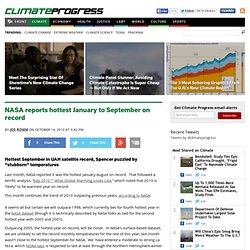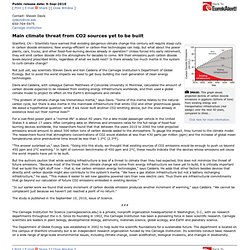

Methane. The Distracting Debate Over Climate Certainty - Dot Earth Blog. Asteroid Watch - jpl.nasa.gov. Recent News February 5, 2015NASA's Dawn spacecraft, on approach to dwarf planet Ceres, has acquired its latest and closest-yet snapshot of this mysterious world. › Read more January 27, 2015NASA's Dawn spacecraft has returned the sharpest images ever seen of the dwarf planet Ceres. › Read more January 22, 2015There has been a significant increase in the amount of water "pouring" out of the Rosetta mission's comet. › Read more › More news Next Five Close Approaches Average distance between Earth and the moon is about 239,000 miles (385,000 kilometers).

The Asteroid Watch Widget tracks asteroids and comets that will make relatively close approaches to Earth. The Widget displays the next five Earth approaches to within 4.6 million miles (7.5 million kilometers or 19.5 times the distance to the moon); an object larger than about 150 meters that can approach the Earth to within this distance is termed a potentially hazardous object. Shhh! The story that ‘sceptics’ don’t want you to read - July - 2011 - Commentary - News and media - Grantham Research Institute on Climate Change and the Environment. 8 July 2011 It is the story that self-proclaimed climate change 'sceptics' have been hoping to keep quiet.

A journal paper that purported to prove that some climate scientists had abused the peer review process has sensationally been retracted following allegations of plagiarism. The article 'Social networks of author-coauthor relationships'|, by Yasmin Said, Edward Wegman, Walid Sharabati and John Rigsby, was published in the journal 'Computational Statistics & Data Analysis' in August 2007. Climate: The hottest year. NASA reports hottest January to September on record « Climate Progress.
By Joe Romm on October 14, 2010 at 3:42 pm "NASA reports hottest January to September on record" Hottest September in UAH satellite record, Spencer puzzled by “stubborn” temperatures Last month, NASA reported it was the hottest January-August on record.

That followed a terrific analysis, “July 2010 “” What Global Warming Looks Like,” which noted that 2010 is “likely” to be warmest year on record. This month continues the trend of 2010 outpacing previous years, according to NASA: It seems all but certain we will outpace 1998, which currently ties for fourth hottest year in the NASA dataset (though it is technically described by NASA folks as tied for the second hottest year with 2005 and 2007). Outpacing 2005, the hottest year on record, will be closer. Remarkably, even Roy Spencer’s much rejiggered UAH data for the lower troposphere shows September 2010 as the hottest on record — a full 0.15 C higher than September 1998. Two Win Nobel for Work on Ultra-Thin Material. Main climate threat from CO2 sources yet to be built. Public release date: 9-Sep-2010 [ Print | E-mail Share ] [ Close Window ] Contact: Steven Davissjdavis@ciw.edu 650-704-5975Carnegie Institution Stanford, CA— Scientists have warned that avoiding dangerous climate change this century will require steep cuts in carbon dioxide emissions.

New energy-efficient or carbon-free technologies can help, but what about the power plants, cars, trucks, and other fossil-fuel-burning devices already in operation? Unless forced into early retirement, they will emit carbon dioxide into the atmosphere for decades to come. Not just yet, say scientists Steven Davis and Ken Caldeira of the Carnegie Institution's Department of Global Ecology. Davis and Caldeira, with colleague Damon Matthews of Concordia University in Montreal, calculated the amount of carbon dioxide expected to be released from existing energy infrastructure worldwide, and then used a global climate model to project its effect on the Earth's atmosphere and climate. Interview with Craig Venter: 'We Have Learned Nothing from the Genome' - SPIEGEL ONLINE - News - International. Revisiting the Younger Dryas. Guest Commentary by Chris Colose One of the most intriguing and well-studied climatic events in the past is the Younger Dryas (YD), a rather abrupt climate change between ~12.9 and 11.6 thousand years ago.

As the world was slowly warming and ice was retreating from the last glaciation, the YD effectively halted the transition to today’s relatively warm, interglacial conditions in many parts of the world. This event is associated with cold and dry conditions increasing with latitude in the North, temperature and precipitation influences on tropical and boreal wetlands, Siberian-like winters in much of the North Atlantic, weakening of monsoon intensity, and southward displacement of tropical rainfall patterns. RealClimate has previously discussed the YD (here and here) however there have been a number of developments in recent years which deserve further attention, particularly with respect to the spatial characteristics and causes of the YD. Fig. 1. Fig. 2. Fig. 4. The Oddities Of Sea-Level Rise. The way we're warming the planet, we can probably expect sea levels to rise at least a meter, on average, by the end of the century.

That's what most scientific projections suggest, anyway. One kink, though, is that that's just an average—the seas won't go up uniformly by one meter all across the globe. Some places will see much higher rises than that, some places much lower. Michael Lemonick has a great Environment360 piece delving into some of the factors that make sea-level rise so odd and unpredictable. Wind patterns, for instance: - Salon.com - Have you no shame, Sen. Inhofe? More fallout from ClimateGate: Sen.

James Inhofe, the ranking minority member of the Senate Environment and Public Works Committee, is calling for a “criminal investigation” into global warming. [The] Minority Staff of the Senate Committee on Environment and Public Works believe the scientists involved may have violated fundamental ethical principles governing taxpayer-funded research and, in some cases, federal laws.
In addition to these findings, we believe the emails and accompanying documents seriously compromise the IPCC -backed “consensus” and its central conclusion that anthropogenic emissions are inexorably leading to environmental catastrophes. Grantham Institute for Climate Change - Imperial. Is the NYT ignoring "Climategate"? Part II.
'Climategate' scientist speaks out. NOAA Climate Services. Climate consensus under strain. George Monbiot Tremendous damage is done These scandals have done tremendous damage.

This is not because they threaten the canon of climate science – that would require similar exposés of tens of thousands of scientific papers – but because they create an atmosphere of opacity and evasion. Rajendra Pachauri's initial dismissal of questions over the Intergovernmental Panel on Climate Change's Himalayan glacier date suggests a failure to listen, which is inimical to scientific discourse. I am also amazed to learn that the IPCC doesn't pay its chairman, obliging him to work elsewhere, which has caused the other scandal in which he's embroiled. Throughout the hacked emails scandal, the University of East Anglia has failed to engage with public concerns or to offer convincing explanations. George Monbiot is a Guardian columnist Vicky Pope. Climate science: the IPCC controversy explained. Ntroversy behind climate science's 'hockey stick' graph.
The pioneering 'hockey stick' graph collected proxy temperature data from tree rings, lake sediments and ice cores It is a persuasive image.

The "hockey stick" graph shows the average global temperature over the past 1,000 years. For the first 900 years there is little variation, like the shaft of an ice-hockey stick. Then, in the 20th century, comes a sharp rise like the stick's blade. The graph was a pioneering attempt to put together data from hundreds of studies of past temperature using "proxies" from analysing things like tree rings, lake sediments and ice cores. 'Climate emails hacked by spies' - Climate Change, Environment. The emails were stolen from a backup computer server used by the University of East Anglia.

They contained private discussions between climate scientists that have embarrassed those involved, particularly Professor Phil Jones, who has stepped down from his post as head of the unit pending an independent inquiry into whether there is any evidence of scientific misconduct. Why The IPCC Needs Fixing. C.I.A. Revives Data-Sharing Program With Environmental Scientists.